
|
Panasonic DMC-L1 An attempt of news analysis |

|
My other articles related to the |
|
Everybody and his mother on the Web are writing what they think about the Panasonic Lumix DMC-L1 camera, unveiled at the February, 2006 PMA show.
Let me put in my two pence. |
|
Announced at the Photo Marketing Association (PMA) show in Orlando, Florida, camera is the first Panasonic product being an effect of their co-operation agreement with Olympus. It shares a number of features, specs, and even some parts and sub-assemblies with the new Olympus E-330, but, no doubt, it is a quite different model than its Olympus cousin. The significance of the Panasonic announcement goes beyond just one new camera model. There are at least two more aspects to it:
The new camera will accept all existing Four Thirds lenses (made so far by Olympus and Sigma), at the same time bringing to the table some new ones of its own. For starters, there is a Leica D Vario Elmarit bundled with the L1; others will, without a doubt. follow shortly. The L1 is also compatible with the current Olympus flash system (FL-50, FL-36, FL-20, plus macro and ring units), and I have seen pictures of the FL-50, slightly modified and re-branded as Panasonic. (Actually, of the Olympus models at least the FL-20 is made by Panasonic anyway. Small world.) |
|
The first look at the L1 gives out a lot. First of all, this is, no doubt, the cleanest-looking SLR on the market, period. Elegant and understated; the only comparison which comes to mind is that with Leica rangefinders. The quality of construction and finish reminds the Panasonic EVF model, the LC1. It indicates that the manufacturer aims here at the same up-level market: advanced amateurs with deep pockets. The LC1 was introduced at $1800; I expect the new L1 to cost at least that much. Some people will find this objectionable, some will not. |
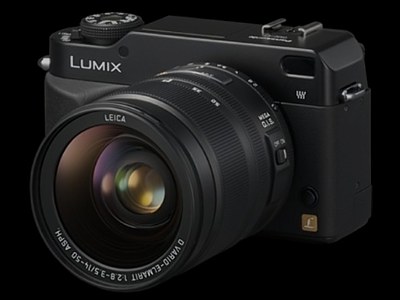
|
|
Generally, I am not against paying extra for the quality, feel, and ergonomics, after my picture-taking requirements are met. How much extra, remains uncertain. Assuming camera's specs and performance are close to the new Olympus E-330 ($1100), is an extra $700 a price worth paying for the look, feel, and convenience? With a difference of, say, $300, I would have no doubts; the way things are, I am not sure. The answer depends on the buyer. I am sure that a significant number of people (mostly middle-aged men like myself) will be willing to pay the price. | |
| In a welcome departure from the industry tradition, Panasonic does not offend our intelligence writing the camera's specs all over its body, like in "9.23 Megapixel Super Matrix" or "Turbo XYZ Image Processing", or "Hyper-Crystal LCD". That is simply bad taste, and getting rid of this blurb is already worth at least $50. |
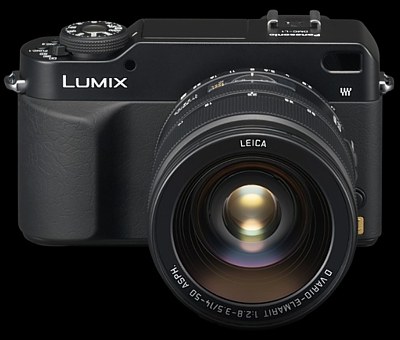
|
|
The flat-top body was made possible by using the same mirror chamber assembly as that in the E-330, together with the side-swinging mirror, three mirrors redirecting the light to the eyepiece, and yet another mirror, directing some of it towards the exposure-metering matrix, and letting some through to the live-preview image sensor.
Yes, like the E-330, the L1 offers a live, electronic image preview. Details are discussed in my An important, and often overlooked, feature is the use of the Olympus ultrasound dust-cleaning system. After having used three SLR sharing the same solution, I can say it really works, making more difference than many numeric specs, hotly argued upon in discussion groups (like how much lower the noise becomes if you increase the sensor size by 13% linear). | |
|
Another distinguishing, and most welcome, feature of the L1 is that the essential controls are of the "classic", external type, not accessed via the menu/button system.
(The champion in this ergonomically superior approach is Minolta Maxxum 7D; unfortunately, no longer in production, unless Sony revives the folded Konica-Minolta SLR operations.) The aperture is set via the ring on the lens, simple and intuitive. Shutter speeds are changed with their own dial at the right. Setting either of these controls to A (for "auto") puts the camera in the shutter or aperture priority mode, respectively; setting both to A means program exposure. (This approach, I believe, was introduced by Pentax in their film SLRs. It makes the exposure mode switch redundant, and I find it more logical than anything else.) |
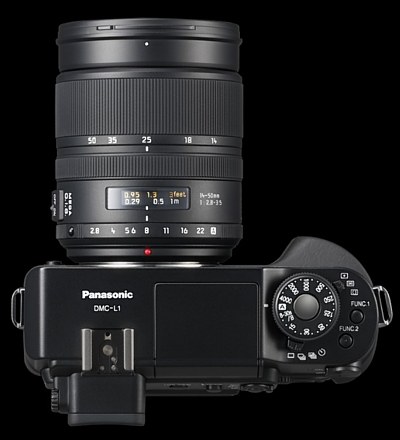
|
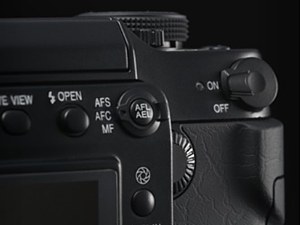
|
The not-so-good news: Olympus or Sigma lenses do not feature an aperture ring. When using those on the L1, you will have to press a button on the camera back and turn the (vertically-mounted, partially hidden) control wheel. That wheel's placement and orientation are different than we got used to. I am not sure how prone it is to accidental turn by your right thumb, and what, if anything, does it control when no button is depressed. |
|
Note the mechanical lever controlling the focusing mode, placed on a ring around the AE/AF lock button. This may be nice or cumbersome, depending how it is implemented. Only handling a production camera will answer this. | |
|
The shutter speed dial allows for speed settings ranging from 1/4000 to 1/10s in 1/3 EV increments. The "A" position is used to set the camera to aperture priority or program mode.
Unfortunately, speeds from 1/8 to 30 seconds had to be allocated to just one dial position, so selecting between them must be done the control wheel and monitor screen. Not really a big deal, as speeds slower than 1/10s are not that often used.
Still, this could have been avoided (or at least pushed down towards slower speeds) by setting the shutter in |
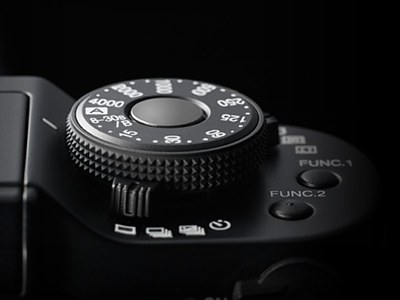
|
|
The picture above reveals more information about operating the camera. First of all, notice the lever switching between drive modes (single, serial, exposure bracketing, and self-timer). Very neat. Another, similar lever (mostly obscured at 2 o'clock) switches between metering patterns (matrix, center-weighted, and spot). Then, there are two function buttons, assignable to a number of possible functions; using, most probably, the press-and-turn metaphor. Last but not least, the shutter release button is placed in the center of the shutter speed dial. I hope the latter has a proper indentation and/or locking mechanism to avoid accidental changes. Once again, the devil is in details, and this may make it or break it. | |
|
The eyepiece looks like that in the E-330. Because of the shared mirror chamber, I would expect the magnification and brightness to be the same: adequate if not impressive.
The LCD monitor has the same specs as that in the E-500 and E-330: 65 mm (2.5") diagonal, 210k pixels (or rather RGB subpixels). This is probably the same monitor, made by Sharp: sharp, bright, and viewable. Note that the monitor does not tilt. This may be a limitation for some users, but it allows to keep the camera relatively thin. |
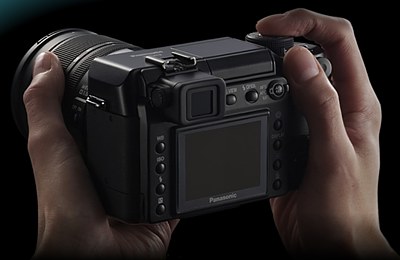
|
|
The layout of controls on the camera's back is quite different than in Olympus models; clearly, Panasonic has its own ideas about this. The four buttons aligned vertically to the left of the monitor control white balance, ISO, flash mode, and flash exposure compensation. (I am pretty sure they do that together with the control wheel). A similar row at the right is used for DOF preview, turning the display on/off, reviewing, and deleting pictures on the card. Above the monitor, in addition to the AE/AF lock, you will find buttons for switching the live view on/off (possibly also changing between two preview modes), and for popping up the flash. Having two vertical rows of buttons allowed the designers to use the cursor ones only for their primary function: screen navigation. (In Olympus SLRs they double up as dedicated control buttons when the screen is not active.) While this is not a big deal, the Panasonic design is cleaner and more elegant. The hot shoe is identical to that used by Olympus; not just the placement of contacts, but even the pesky plastic cover I hate so much from day one (did I mention I already lost six of those?). This is good news, as (a) the camera can use the available Olympus flash units; (b) if Panasonic decides to devote resources to develop flash units for the L1, they will be, most probably, compatible with E-System cameras. This may only benefit the users of both brands. Under the hood, Panasonic is using the same 7.5 megapixel MOS imager the E-330 uses. The sensor is made by Panasonic, and 7.5 MP is just 3% less in linear resolution than 8 MP in the E-300 and E-500. The L1, however, uses its own, proprietary image-processing engine. The sensor is claimed to have a good dynamic range and low levels of high-ISO noise, but this is what all makers say in their press releases, so I would wait with any comments on this until I see (or preferably shoot) some samples. From other specs we know only that the camera uses SD (Secure Digital) memory cards, and supports the FAT-32 file system, thus allowing for cards bigger than 2 GB. | |
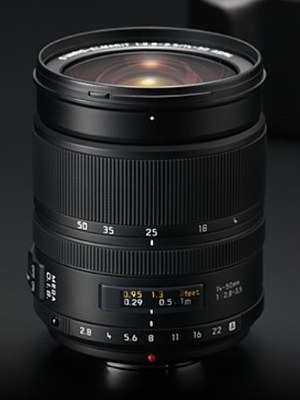
|
The kit lens coming with the L1 is the Leica D Vario-Elmarit 14-50 mm, F/2.8-3.5.
While the specs look close to those of the Olympus ZD 14-54/2.8-3.5, this is an entirely different lens, with entirely different optical design. Importantly, it uses the Panasonic image stabilization system (it is referred to as Mega O.I.S., which means exactly nothing). There are two image stabilization modes: full-time, and on half-pressing the shutter release. The stabilization will also work when the lens is used on Olympus bodies, albeit only in full-time mode. Contrary to some rumors this is not just a matter of a 25-cent switch; it requires a change in the body-to-lens communication protocol. In theory, this can be done in a firmware update, but nobody knows if this is a realistic expectation. Some Olympus users rejoice having, at last, a stabilized lens to use with their cameras, but I believe the issue is overblown, at least for lenses with moderate focal lengths. Maybe I will warm up to IS lenses if I use them for a longer period of time. |
|
In the Panasonic system, a built-in gyroscope system detects camera shake, and a micromotor compensates for it by laterally moving a dedicated optical element (shown as the rightmost one in the center triplet). It remains unclear what is the actual involvement of Leica Camera AG in the lens, besides allowing Panasonic to use the Leica brand name on it. All Panasonic and Leica statements are phrased very carefully, not to reveal anything. This is not really important: if the lens is good (and this is expected), it does not matter who actually designed or made it. |
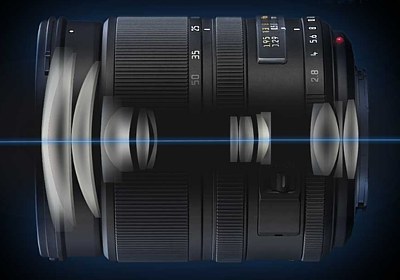
|
|
This is all we know at this time. As the camera is at least six months from the production stage, many things may still change. Even this early, however, the L1 already looks like a very attractive option for those who can afford it, as long as the actual execution of the design is flawless, and the image quality meets the high expectations. To know how this turns out we will have to wait until, probably, September. | |

|
My other articles related to the |
|
Evolt® and Olympus® are registered trademarks of Olympus Corporation.
Panasonic® and Lumix® are registered trademarks of Matsushita Corporation. Leica® is a registered trademark of Leica Camera AG. This page is not sponsored or endorsed by Olympus, Panasonic, or Leica, and presents solely the views of the author. |
| Home: wrotniak.net | Search this site | Change font size |
| Posted 2006/03/05; last updated 2006/05/06 |
Text copyright © 2006 by J. Andrzej Wrotniak
Images © 2006 by Panasonic |